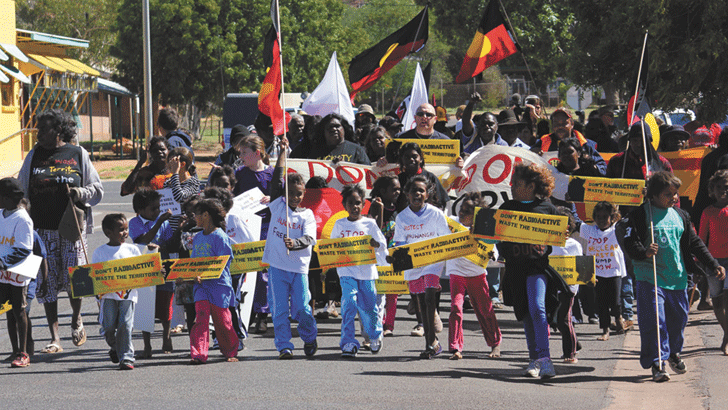No NT nuclear waste dump!

Despite clear opposition from the Aboriginal traditional owners, the push for a nuclear waste dump at Muckaty Station, 120 kilometres north of Tennant Creek in the Northern Territory, continues.
The campaign led by traditional owners to stop the waste dump is gearing up for the next stage in the fight.
On 26 August, the Federal Court set June 2014 for a case to be heard on whether the nomination of the site for the waste dump followed due process. The nuclear free campaigner for the Australian Conservation Foundation, Dave Sweeney, told Red Flag:
“The case has been brought by a group of senior Aboriginal traditional owners who argue that both the Commonwealth and the Northern Land Council (NLC) have failed in their statutory duty to identify, engage and obtain consent from the appropriate Aboriginal owners. They are seeking to have the existing nomination ruled invalid.”
Muckaty was nominated by the NLC with the support of only one of the five clan groups holding ownership and cultural ties to Muckaty Station.
The Rudd-Gillard Labor government has used divide and rule tactics, former resources minister Martin Ferguson boasting at one stage that he had offers for numerous locations across the NT for a waste dump if Muckaty Station fell through.
Opposition ignored
Barb Shaw, an Aboriginal activist with connections to Muckaty Station, told Red Flag, “There has always been opposition to the nuclear waste dump on Muckaty … There has been a campaign running ever since the site was nominated and announced. There has been big opposition from Aboriginal and non-Aboriginal people, from right across Australia.”
Shaw explained: “People from four of the clan groups have travelled around Australia talking about the nuclear waste dump. There has been a nuclear-free ride from Lucas Heights all the way to Muckaty … People are aware of it and do oppose it, because they know it is wrong and that the waste hasn’t come from this country, yet they want to put it in the country. Aboriginal people are very culturally and traditionally connected to the land … any form of nuclear waste is not part of our culture.”
Shaw is concerned by the nomination process and the role of the NLC. “There is a need for free, prior and informed consent in this issue, but there was no information given to the people. They weren’t properly informed about the waste dump, and they haven’t been able to give full consent if they want a nuclear waste dump there or not”, she said.
Spurious excuses
The rationale for the dump is spurious. There is no compelling scientific or public safety necessity for one to be built.It has been repeatedly claimed that a specialised waste dump is required to safely store low level waste (LLW) and long lived intermediate level waste (LLIW).
Most of the LLW is derived from medical isotopes used in hospitals and clinics, while the LLIW comes almost exclusively from the nuclear reactor at Lucas Heights in Sydney. It is this latter type of waste that is of most concern because it is highly toxic and radioactive for a lengthy period.
Sweeney explains further: “In the 1990s there was a departmental decision made that the best way to manage Australia’s radioactive waste was through developing a centralised remote dump or store. This decision was made by unelected bureaucrats and has since been uncritically adopted and advanced by successive federal governments. A remote dump is one way to manage waste; it is not the only way and has never been proven to be the best way.”
The push for a nuclear waste facility also ties in with a desire by the Australian ruling class to maintain a stake in the global nuclear industry. Aboriginal rights, the safety of workers and environmental concerns are being quashed or ignored in order to pursue profit.
The justification for storage of medical waste is also a complete furphy. Sweeney told Red Flag, “The medical myth is a deeply disturbing aspect of the Muckaty story. Both major parties have consistently misrepresented the situation by claiming that the Muckaty dump is needed to ensure Australians have access to nuclear medicine for therapeutic and diagnostic reasons.
“This is not the case – and medical waste is not the driver for the planned dump. Medical and public health bodies including the Medical Association for the Prevention of War and the Public Health Association of Australia have repeatedly condemned the conflation of these issues”, he said.
The promotion of the waste dump on an economic basis, including for local Aboriginal communities, also deeply concerns Shaw. “It is disgusting to talk about a nuclear waste dump as being part of economic development because there is no economic development in nuclear waste dumping”, she said.
“People around the country need to do their homework. They need to look at Mother [Nature] at work, especially when we have had accidents like Chernobyl, the tsunami in Japan and Fukushima, and of course there is the bombing of Maralinga here. The general public needs to think about whether they want to have nuclear waste travelling through their towns and their states, because accidents do happen.”
Whatever the outcome of the legal proceedings, Sweeney says that a public campaign needs to continue, including a transparent discussion about what to do with existing nuclear waste – simply passing unjust legislation and railroading Aboriginal and community rights is not the answer. “We need to move from the failed search for a vulnerable postcode to a genuine commitment to a credible process. Radioactive waste lasts longer that any politician’s promise, and we need to get its management right. This needs to be based on sound science and open and inclusive decision making and reflect international best practice. None of this is occurring at Muckaty.”